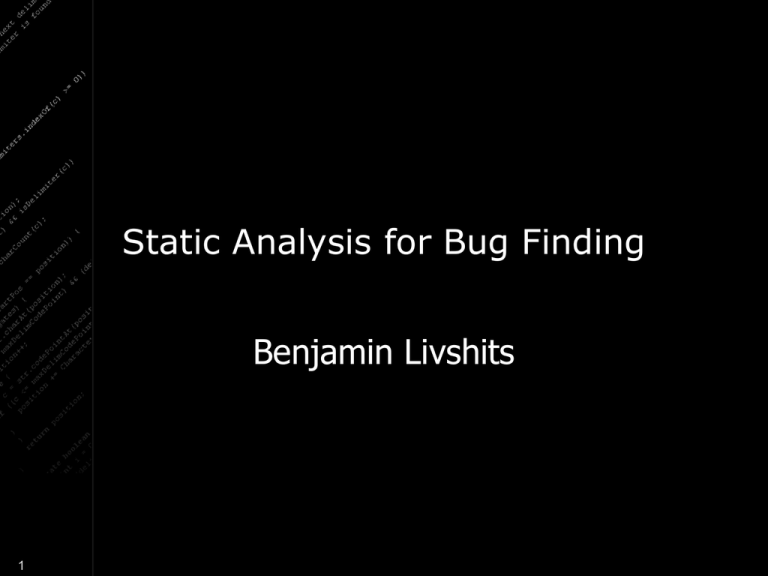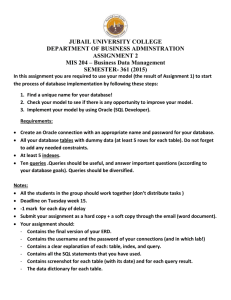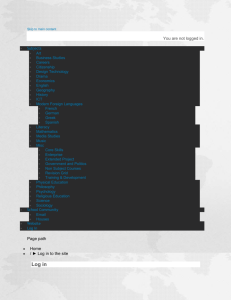Static and Dynamic Protection from Vulnerabilities for Web
advertisement

Static Analysis for Bug Finding
Benjamin Livshits
1
Compilers Can be Used for Bug Finding
• A trend of compiler research
• Started in 1991 with Intrinsa
–
–
–
–
–
Bug finding tool called Prefix
Looks for NULL dereferences
Memory leaks (double-deletes, dangling pointers)
Concurrency bugs (race conditions)
etc.
• Purchased by Microsoft
– Became Prefix/Prefast
– Used by MS internally on a regular basis
2
Why Compilers?
• Observation:
– Many bugs can be found by analyzing
the source code
– Compilers have access to the source
• Security is an attractive application:
– The cost of a break-in is very high
– Sound static (compiler) analysis can find
all bugs
3
Common Classes of Security Vulnerabilities
4
• Server-type software
(C, C++)
• Buffer overruns
• Format string violations
• Application software
(Java, C#, PHP)
•
•
•
•
•
•
SQL injections
Cross-site scripting attacks
HTTP splitting attacks
Directory traversal attacks
Session hijacking attacks
etc.
Buffer Overruns
5
How Buffer Overruns Work
• There is no array bounds checking in C
• Hackers can exploit that
• Different flavors of overruns
– Simplest: overrun a static buffer
– Idea: Don’t want user data to be copied to static buffers!
1. Arrange for suitable
code to in program
address space
2. Get the program to
jump to that code
overwrite a return address
to point to the code
3. Put something
interesting into the
exploit code
–
6
such as exec(“sh”), etc.
Example: Buffer Overrun in gzip
gzip.c:593
0589
0590
0591
0592
0593
if (to_stdout && !test && !list && (!decompress || ...
SET_BINARY_MODE(fileno(stdout));
}
while (optind < argc) {
treat_file(argv[optind++]);
gzip.c:716
0704 local void treat_file(iname)
0705
char *iname;
0706 {
...
0716
if (get_istat(iname, &istat) != OK) return;
gzip.c:1009
0997 local int get_istat(iname, sbuf)
0998
char *iname;
0999
struct stat *sbuf;
1000 {
...
1009
7
Need to have a
model of strcpy
strcpy(ifname, iname);
A Glimpse of What Analysis is Needed
• Need it to represent flow of date in C:
a = 2;
*p = 3;
…
is the value of a still 2?
• Yes if we can prove that p cannot point to a
• Should we put a flow edge from 3 to a to
represent potential flow?
• If we don’t
– Analysis may miss bugs
• If we do
– Analysis may end up being too imprecise
8
Application Level Vulnerabilities
(SQL Injection & Friends)
9
Real-Life Hacking Stories
•
•
•
•
•
•
•
•
•
blogger.com cracked
Firefox marketing site hacked
MS UK defaced in hacking attack
Hacker hits Duke system
MSN site hacked in South Korea
MSN site hacking went undetected for days
Phishers manipulate SunTrust site to steal data
Tower Records settles charges over hack attacks
Western Union Web site hacked
Aug. 2005
Jul. 2005
Jul. 2005
Jun. 2005
Jun. 2005
Jun. 2005
Sep. 2004
Apr. 2004
Sep. 2000
•
75% of all security
attacks today are at the
application level*
•
97% of 300+ audited
sites were vulnerable to
Web application attacks*
•
$300K average financial
loss from unauthorized
access or info theft**
•
Average $100K/hour of
downtime lost
* Source: Gartner Research
*Source: Computer Security Institute survey
10
Simple Web App
• Web form allows user to look up account details
• Underneath – Java Web app. serving requests
11
SQL Injection Example
•
Happy-go-lucky SQL statement:
String query = “SELECT Username, UserID, Password
FROM Users WHERE
username =“ + user + “ AND
password =“ + password;
•
Leads to SQL injection
–
•
But how?
–
–
–
12
One of the most common Web application vulnerabilities
caused by lack of input validation
Typical way to construct a SQL query using concatenation
Looks benign on the surface
But let’s play with it a bit more…
Injecting Malicious Data (1)
submit
query = “SELECT Username, UserID, Password
FROM Users WHERE
Username = 'bob'
AND Password = ‘********‘”
13
Injecting Malicious Data (2)
submit
query = “SELECT Username, UserID, Password
FROM Users WHERE
Username = 'bob‘-‘AND Password = ‘ ‘”
14
Injecting Malicious Data (3)
submit
query = “SELECT Username, UserID, Password
FROM Users WHERE
Username = 'bob‘; DROP Users-‘AND Password = ‘‘”
15
Summary of Attacks Techniques
Input and output validation are at the core of the issue
1. Inject
(taint sources)
2. Exploit
(taint sinks)
•
•
•
•
•
•
•
•
•
•
•
Parameter manipulation
Hidden field manipulation
Header manipulation
Cookie poisoning
Second-level injection
SQL injections
Cross-site scripting
HTTP request splitting
HTTP request smuggling
Path traversal
Command injection
1. Header manipulation + 2. HTTP splitting = vulnerability
16
Focusing on Input/Output Validation
• SQL injection and cross-site scripting are most prevalent
• Buffer overruns are losing their market share
Buffer overrun
HTML Injection
Information
disclosure
18%
Code execution
Cross-site
scripting
Other input
validation
19%
Path traversal
Format string
Integer overlow
30%
SQL Injection
17
HTTP response
splitting
Taint Propagation
String session.ParameterParser.getRawParameter(String name)
public String getRawParameter(String name) throws ParameterNotFoundException
{
String[] values = request.getParameterValues(name);
if (values == null)
{
throw new ParameterNotFoundException(name + " not found");
}
else if (values[0].length() == 0)
{
throw new ParameterNotFoundException(name + " was empty");
}
return (values[0]);
ParameterParser.java:586
}
String session.ParameterParser.getRawParameter(String name, String def)
public String getRawParameter(String name, String def) {
try
{
return getRawParameter(name);
}
catch (Exception e)
{
return def;
}
}
ParameterParser.java:570
Element lessons.ChallengeScreen.doStage2(WebSession s)
18
String user = s.getParser().getRawParameter( USER, "" );
StringBuffer tmp = new StringBuffer();
tmp.append("SELECT cc_type, cc_number from user_data WHERE userid = '“);
tmp.append(user);
tmp.append("'“);
query = tmp.toString();
Vector v = new Vector();
try
{
ResultSet results = statement3.executeQuery( query );
...
ChallengeScreen.java:194
Why Pointer Analysis?
• Imagine manually auditing an application
– Two statements somewhere in the program
– Can these variables refer to the same object?
• Question answered by pointer analysis...
// get Web form parameter
String param = request.getParameter(...);
...
...
...
// execute query
con.executeQuery(query);
19
Pointers in Java?
• Java references are pointers in disguise
Stack
20
Heap
What Does Pointer Analysis Do for Us?
•
Statically, the same object can be passed around in the program:
–
–
–
–
•
Passed in as parameters
Returned from functions
Deposited to and retrieved from data structures
All along it is referred to by different variables
Pointer analysis “summarizes” these operations:
– Doesn’t matter what variables refer to it
– We can follow the object throughout the program
a
b
c
21
Recurring Issues
•
Static analysis is a powerful approach to finding
bugs in program at the source
Soundness: find all bugs of a kind
1.
–
2.
Precision: low rate of false positives
–
3.
can have an extremely precise sound analysis but takes
years to run
Scalability:
•
•
22
Marking every line of the program as a problem
achieves that
Want to analyze programs 10,000-50,000 LOC
Some analyses go up to 1M LOC



